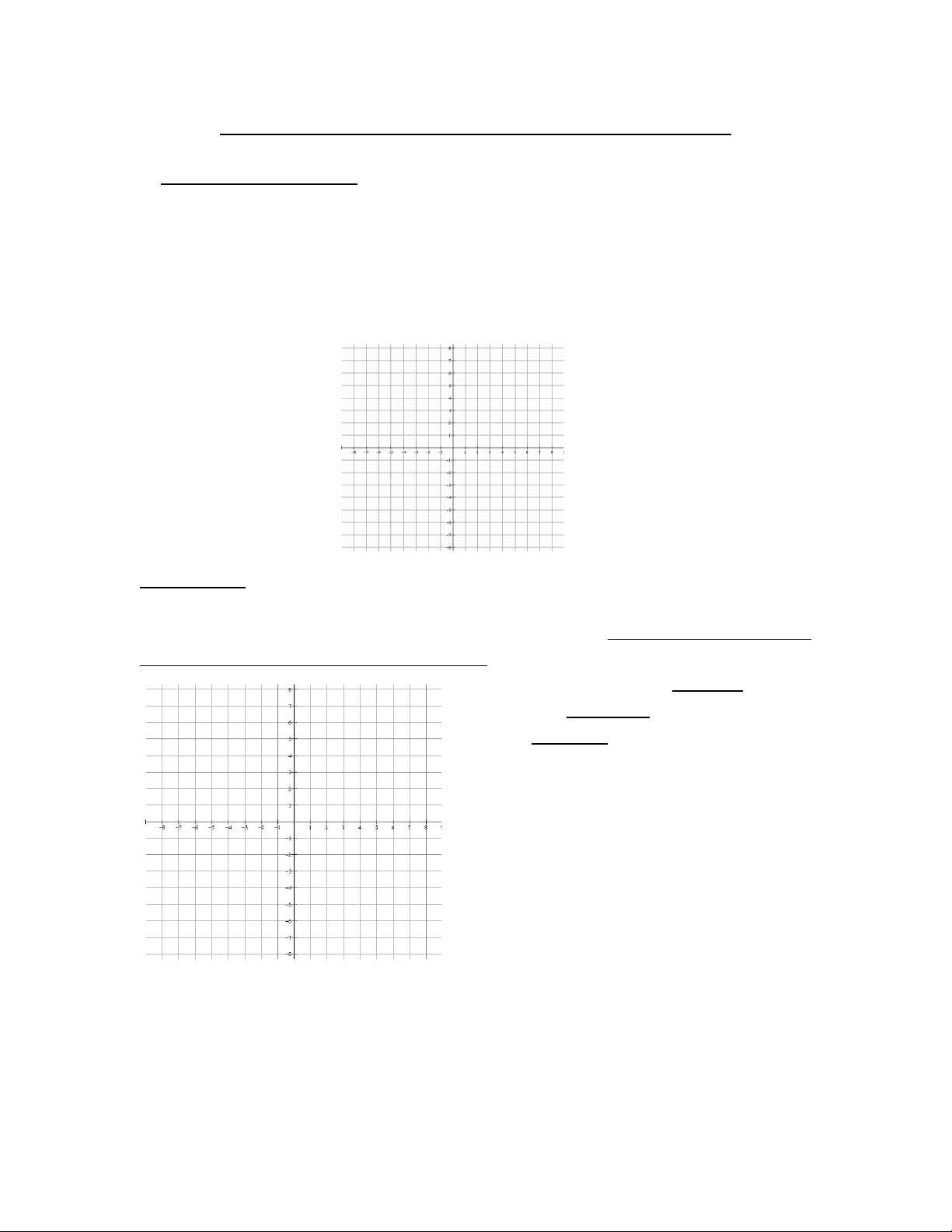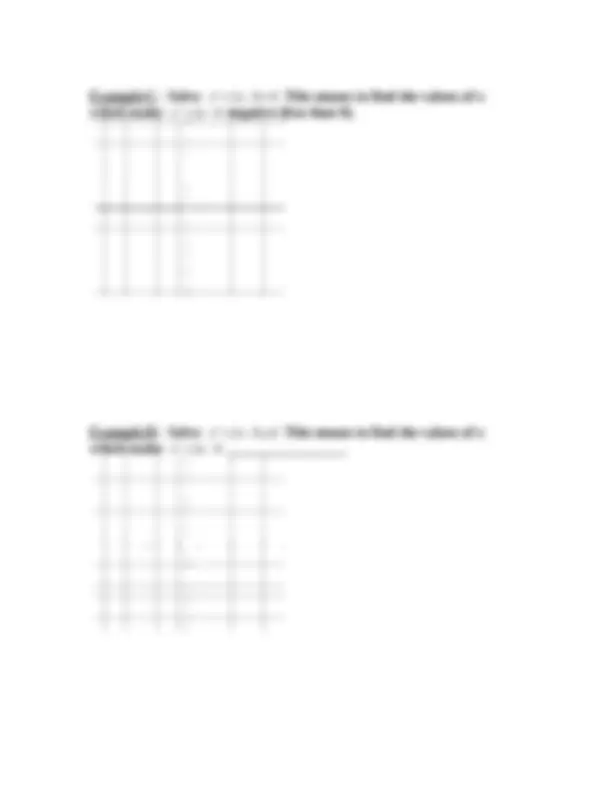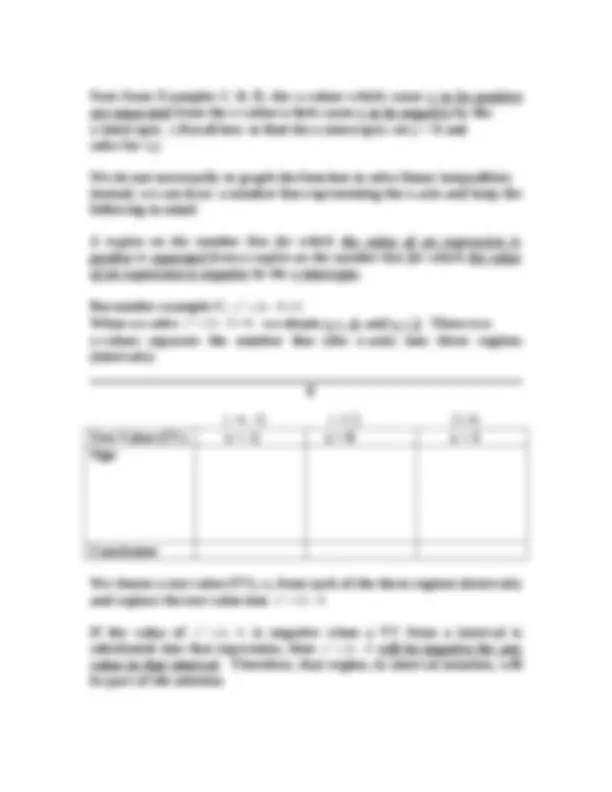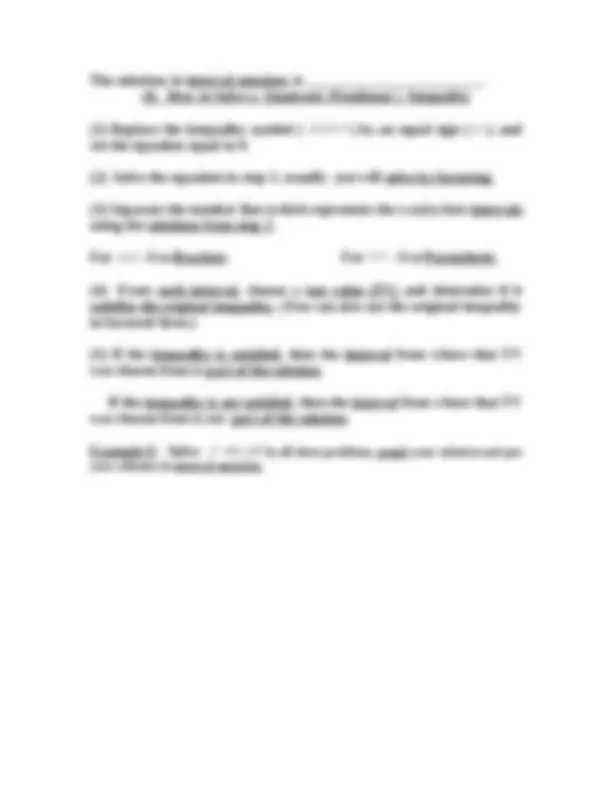







Study with the several resources on Docsity

Earn points by helping other students or get them with a premium plan


Prepare for your exams
Study with the several resources on Docsity

Earn points to download
Earn points by helping other students or get them with a premium plan
Community
Ask the community for help and clear up your study doubts
Discover the best universities in your country according to Docsity users
Free resources
Download our free guides on studying techniques, anxiety management strategies, and thesis advice from Docsity tutors
Material Type: Notes; Professor: Duran; Class: Intermediate Algebra; Subject: Mathematics; University: Sierra College; Term: Unknown 1989;
Typology: Study notes
1 / 9

This page cannot be seen from the preview
Don't miss anything!






A Quadratic Inequality is an inequality that can be written so that one side is a quadratic expression and the other side is 0. Examples: 2 x x 30 0, 2 x^2 9 x 2 0 First, answer these questions: In which quadrants are the y-values positive? In which quadrants are the y-values negative? Example A: Solve 2 x 9 0. This means to find the values of x which make x^2^ 9 positive (greater than 0). One way to do this is to let y x 2 9 , graph this parabola, and then find the values of x that cause the graph to be ________ the x –axis. Again, x^2^ 9 is positive when the parabola y x 2 9 is _______the x-axis. The values of x which cause the graph to be above the x- axis are, in interval notation: _________________________. We can verify this; for instance, let x = _____ or let x =______
Example B: Solve x^2 9 0. This means to find the values of x which make x^2 9 negative (less than 0) or equal to 0. x^2^ 9 is negative when the parabola y x 2 9 is ______ the x-axis or on the x-axis. This occurs in quadrants ___ and ___. One way is to do this to let y x^2 9 , graph this parabola, and then find the values of x that cause the graph to be ______ the x –axis. The values of x which cause the graph to be below or on the x-axis are, in interval notation: ______________________. We can also graph the solution:
0 We can verify this; for instance, let x = _____ or let x =______
Note from Examples C & D, the x-values which cause y to be positive are separated from the x-values which cause y to be negative by the x-intercepts. ( Recall how to find the x-intercepts: set y = 0 and solve for x.) We do not necessarily to graph the function to solve linear inequalities; instead, we can draw a number line representing the x-axis and keep the following in mind: A region on the number line for which the value of an expression is positive is separated from a region on the number line for which the value of an expression is negative by the x-intercepts. Reconsider example C: x^2^ 2 x 8 0. When we solve 2 x 2 x 8 0, (^) we obtain x = -4, and x = 2. These two x-values separate the number line (the x-axis) into three regions (intervals): 0 ( , 4) ( 4, 2) (2, ) Test Value (TV) x = -5 x = 0 x = 3 Sign Conclusion We choose a test value (TV), x, from each of the three regions (intervals) and replace the test value into x^2^ 2 x 8. If the value of 2 x 2 x 8 is negative when a TV from a interval is substituted into that expression, then 2 x 2 x 8 will be negative for any value in that interval. Therefore, that region, in interval notation, will be part of the solution.
The solution, in interval notation, is _________________________. (I) How to Solve a Quadratic (Nonlinear ) Inequality (1) Replace the inequality symbol ( ,^ ,^ ,^ ) by an equal sign ( = ), and set the equation equal to 0. (2) Solve the equation in step 1; usually you will solve by factoring. (3) Separate the number line (which represents the x-axis) into intervals using the solutions from step 2. For ,^ : Use Brackets For ,^ : Use Parenthesis (4) From each interval, choose a test value (TV) and determine if it satisfies the original inequality. (You can also use the original inequality in factored form.) (5) If the inequality is satisfied, then the interval from where that TV was chosen from is part of the solution. If the inequality is not satisfied, then the interval from where that TV was chosen from is not part of the solution. Example E: Solve x^2 6 x 0. In all these problems, graph your solution and put your solution in interval notation.
(II) How to Solve a Rational Inequality (1) Replace the inequality symbol ( ,^ ,^ ,^ ) by an equal sign ( = ), and set the equation equal to 0. (2) Find the solutions that make both the denominator and numerator equal to 0. (3) Separate the number line (which represents the x-axis) into intervals using the solutions from step 2. For ,^ : Use Brackets For ,^ : Use Parenthesis Use parenthesis ( ) on the solution(s) that makes the denominator equal to 0. These values are not part of the solution. (4) From each interval, choose a test value (TV) and determine if it satisfies the original inequality, or the inequality whose right side is 0. (5) If the inequality is satisfied, then the interval from where that TV was chosen from is part of the solution. If the inequality is not satisfied, then the interval from where that TV was chosen from is not part of the solution. Example G: Solve 2
3 x x
Example H: Solve 2 6
5 x x On separate paper, please solve these nonlinear inequalities and graph your solutions and put your solutions in interval notation.